Page 1409 of 1903
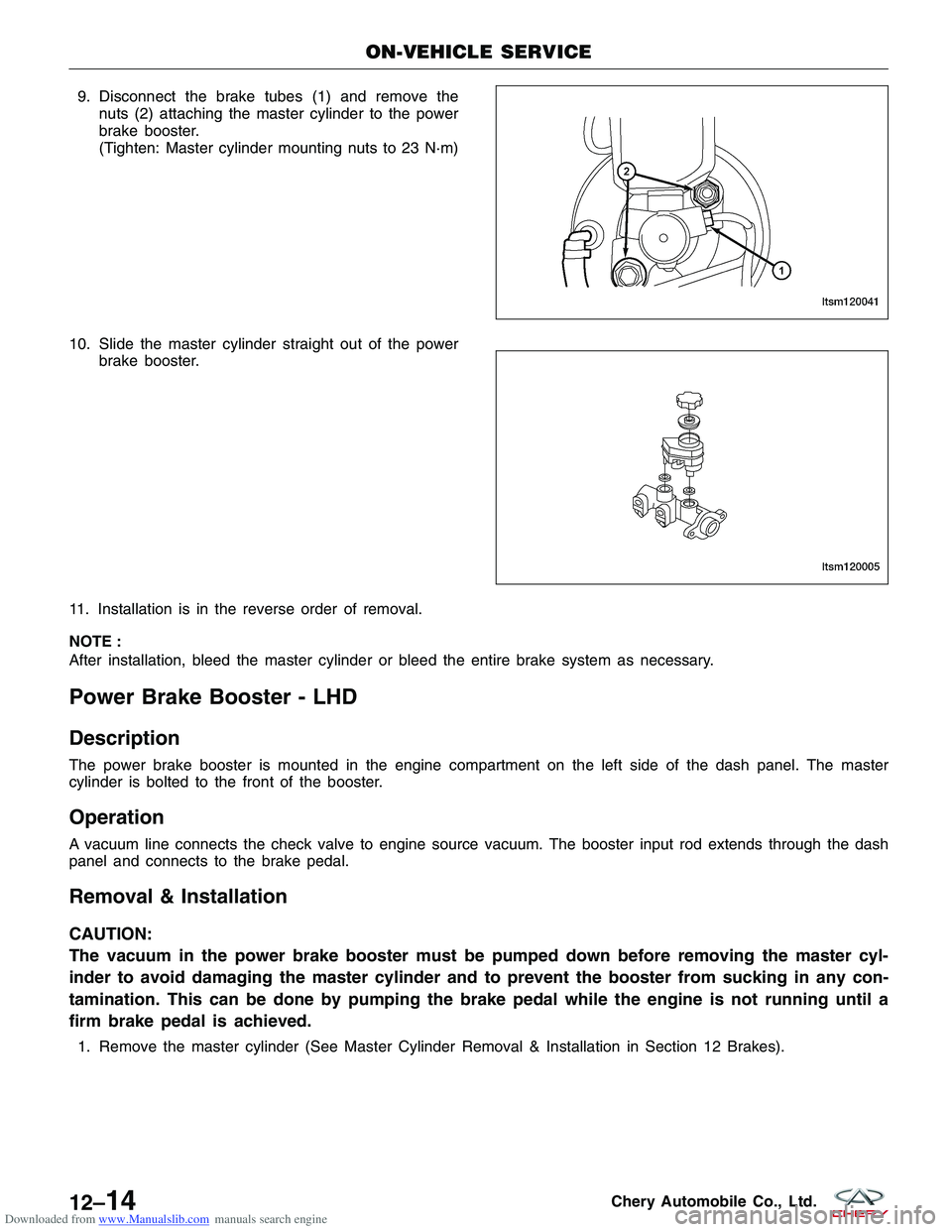
Downloaded from www.Manualslib.com manuals search engine 9. Disconnect the brake tubes (1) and remove thenuts (2) attaching the master cylinder to the power
brake booster.
(Tighten: Master cylinder mounting nuts to 23 N·m)
10. Slide the master cylinder straight out of the power brake booster.
11. Installation is in the reverse order of removal.
NOTE :
After installation, bleed the master cylinder or bleed the entire brake system as necessary.
Power Brake Booster - LHD
Description
The power brake booster is mounted in the engine compartment on the left side of the dash panel. The master
cylinder is bolted to the front of the booster.
Operation
A vacuum line connects the check valve to engine source vacuum. The booster input rod extends through the dash
panel and connects to the brake pedal.
Removal & Installation
CAUTION:
The vacuum in the power brake booster must be pumped down before removing the master cyl-
inder to avoid damaging the master cylinder and to prevent the booster from sucking in any con-
tamination. This can be done by pumping the brake pedal while the engine is not running until a
firm brake pedal is achieved.
1. Remove the master cylinder (See Master Cylinder Removal & Installation in Section 12 Brakes).
ON-VEHICLE SERVICE
LTSM120041
LTSM120005
12–14Chery Automobile Co., Ltd.
Page 1410 of 1903
Downloaded from www.Manualslib.com manuals search engine 2. Remove the spring-type cotter pin (2) and clevispin (1) from the brake booster rod (3).
3. Remove the nuts and bolts (1) attaching the power brake booster to the brake pedal bracket.
(Tighten: Brake pedal/Power brake booster mount-
ing nuts and bolts to 25 N·m)
4. Remove the brake pedal bracket.
5. Disconnect the vacuum hose (1) from the check valve on the power brake booster.
6. Slide the power brake booster (1) forward until its mounting studs clear the dash panel, then remove
it through the engine compartment.
7. Installation is in the reverse order of removal.
ON-VEHICLE SERVICE
BESM120009
LTSM120006
LTSM120004
BESM120028
12
12–15Chery Automobile Co., Ltd.
Page 1411 of 1903
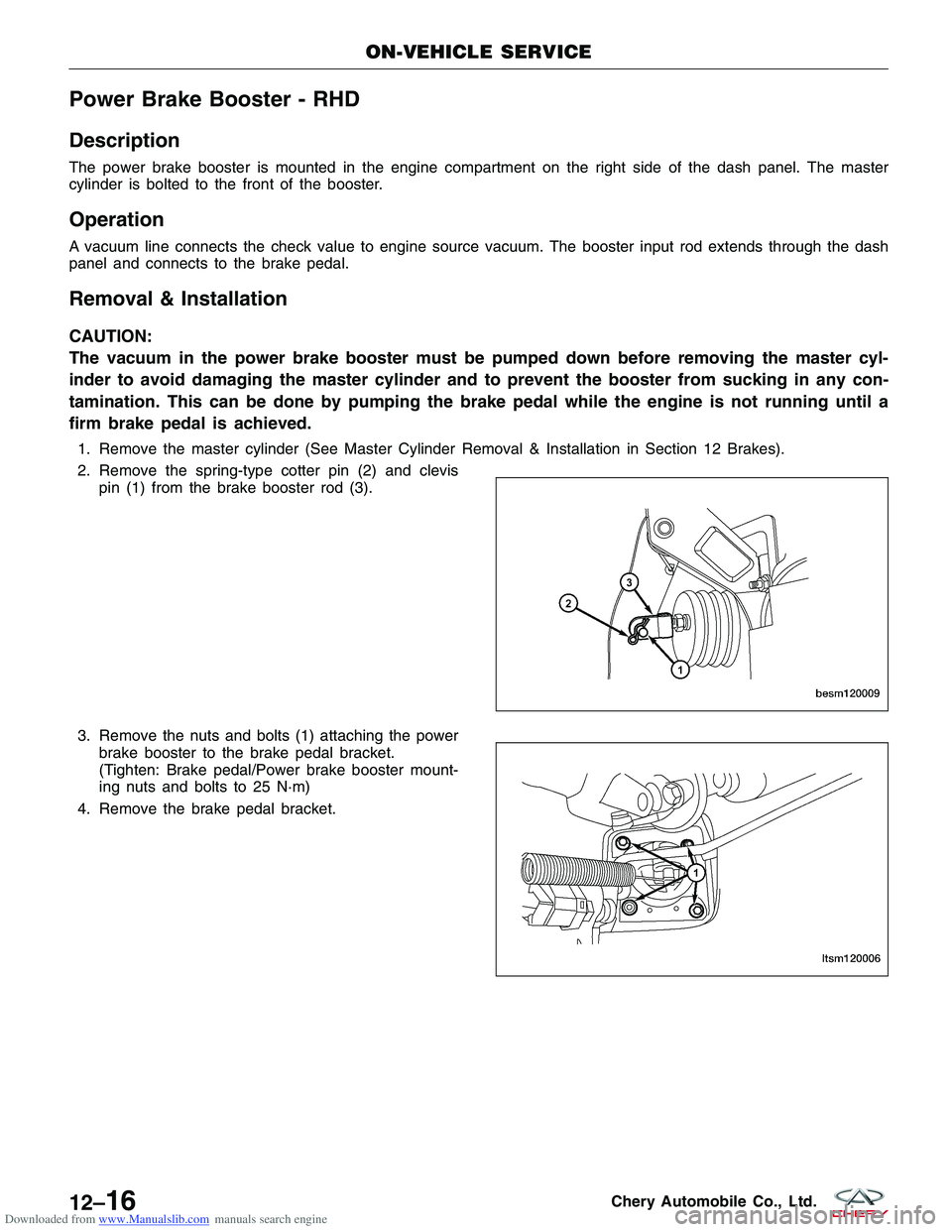
Downloaded from www.Manualslib.com manuals search engine Power Brake Booster - RHD
Description
The power brake booster is mounted in the engine compartment on the right side of the dash panel. The master
cylinder is bolted to the front of the booster.
Operation
A vacuum line connects the check value to engine source vacuum. The booster input rod extends through the dash
panel and connects to the brake pedal.
Removal & Installation
CAUTION:
The vacuum in the power brake booster must be pumped down before removing the master cyl-
inder to avoid damaging the master cylinder and to prevent the booster from sucking in any con-
tamination. This can be done by pumping the brake pedal while the engine is not running until a
firm brake pedal is achieved.
1. Remove the master cylinder (See Master Cylinder Removal & Installation in Section 12 Brakes).
2. Remove the spring-type cotter pin (2) and clevispin (1) from the brake booster rod (3).
3. Remove the nuts and bolts (1) attaching the power brake booster to the brake pedal bracket.
(Tighten: Brake pedal/Power brake booster mount-
ing nuts and bolts to 25 N·m)
4. Remove the brake pedal bracket.
ON-VEHICLE SERVICE
BESM120009
LTSM120006
12–16Chery Automobile Co., Ltd.
Page 1412 of 1903
Downloaded from www.Manualslib.com manuals search engine 5. Disconnect the vacuum hose (1) from the checkvalve on the power brake booster.
6. Slide the power brake booster forward until its mounting studs clear the dash panel, then remove it through the engine compartment.
7. Installation is in the reverse order of removal.
ON-VEHICLE SERVICE
LTSM120004
12
12–17Chery Automobile Co., Ltd.
Page 1413 of 1903
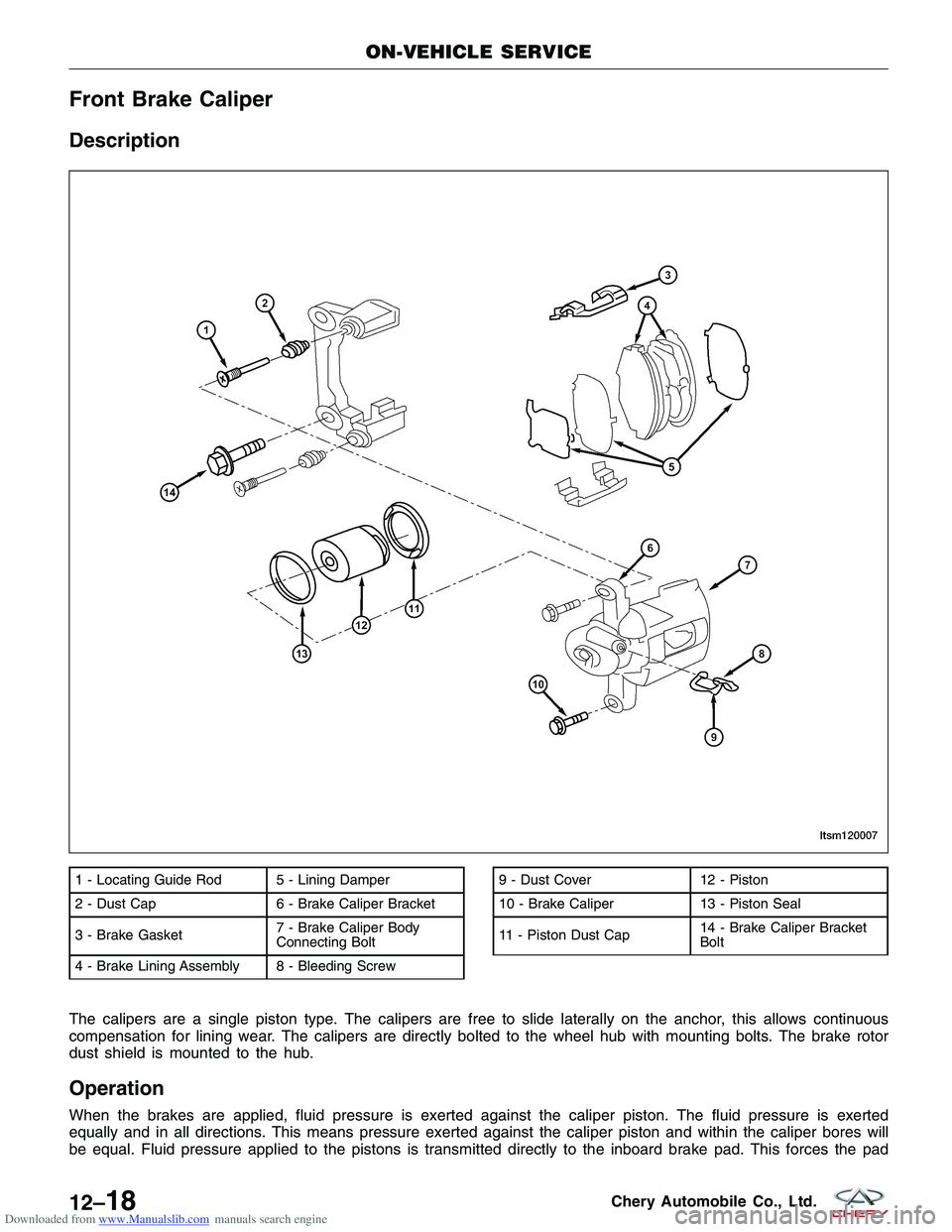
Downloaded from www.Manualslib.com manuals search engine Front Brake Caliper
Description
The calipers are a single piston type. The calipers are free to slide laterally on the anchor, this allows continuous
compensation for lining wear. The calipers are directly bolted to the wheel hub with mounting bolts. The brake rotor
dust shield is mounted to the hub.
Operation
When the brakes are applied, fluid pressure is exerted against the caliper piston. The fluid pressure is exerted
equally and in all directions. This means pressure exerted against the caliper piston and within the caliper bores will
be equal. Fluid pressure applied to the pistons is transmitted directly to the inboard brake pad. This forces the pad
1 - Locating Guide Rod 5 - Lining Damper
2 - Dust Cap 6 - Brake Caliper Bracket
3 - Brake Gasket7 - Brake Caliper Body
Connecting Bolt
4 - Brake Lining Assembly 8 - Bleeding Screw9 - Dust Cover 12 - Piston
10 - Brake Caliper 13 - Piston Seal
11 - Piston Dust Cap 14 - Brake Caliper Bracket
Bolt
ON-VEHICLE SERVICE
LTSM120007
12–18Chery Automobile Co., Ltd.
Page 1414 of 1903
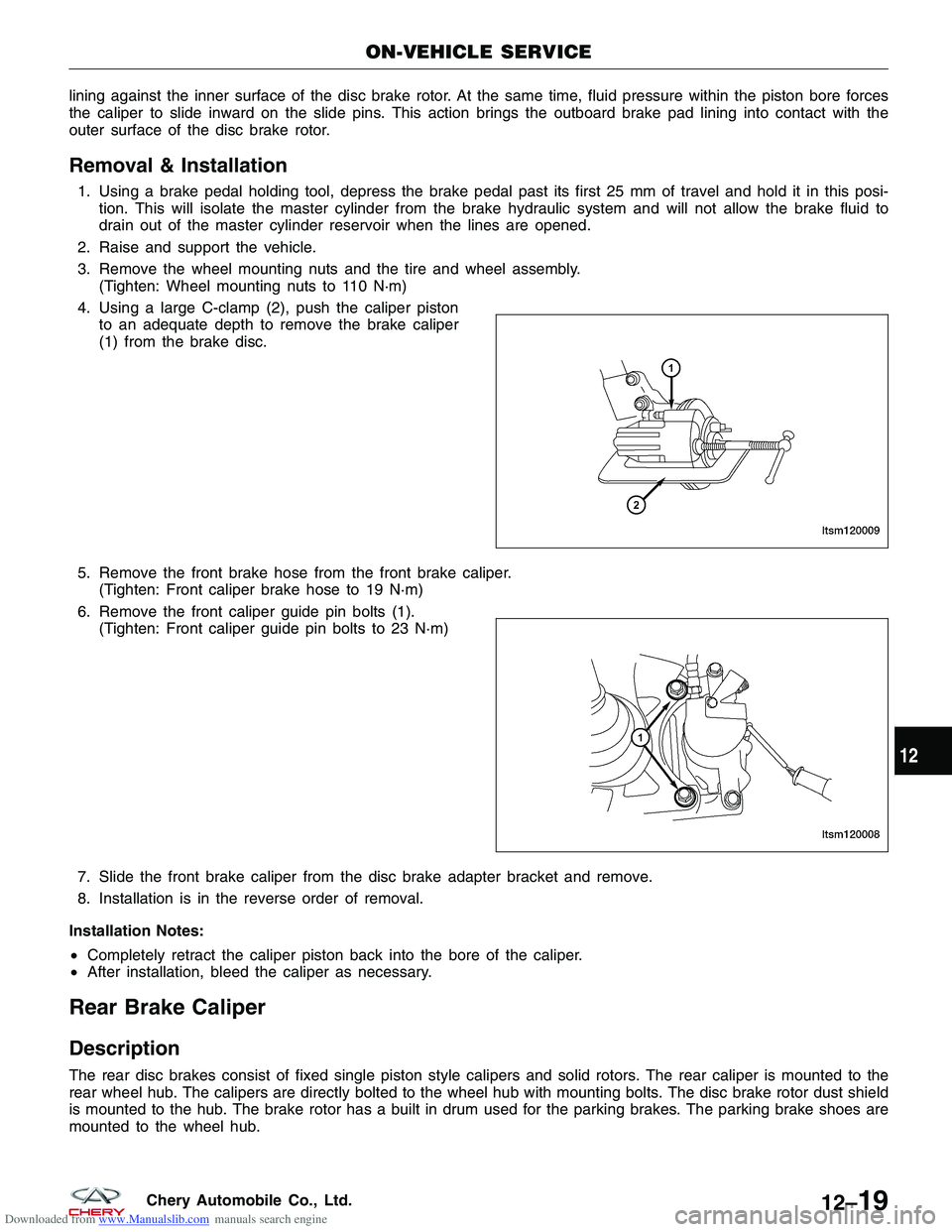
Downloaded from www.Manualslib.com manuals search engine lining against the inner surface of the disc brake rotor. At the same time, fluid pressure within the piston bore forces
the caliper to slide inward on the slide pins. This action brings the outboard brake pad lining into contact with the
outer surface of the disc brake rotor.
Removal & Installation
1. Using a brake pedal holding tool, depress the brake pedal past its first 25 mm of travel and hold it in this posi-tion. This will isolate the master cylinder from the brake hydraulic system and will not allow the brake fluid to
drain out of the master cylinder reservoir when the lines are opened.
2. Raise and support the vehicle.
3. Remove the wheel mounting nuts and the tire and wheel assembly. (Tighten: Wheel mounting nuts to 110 N·m)
4. Using a large C-clamp (2), push the caliper piston to an adequate depth to remove the brake caliper
(1) from the brake disc.
5. Remove the front brake hose from the front brake caliper. (Tighten: Front caliper brake hose to 19 N·m)
6. Remove the front caliper guide pin bolts (1). (Tighten: Front caliper guide pin bolts to 23 N·m)
7. Slide the front brake caliper from the disc brake adapter bracket and remove.
8. Installation is in the reverse order of removal.
Installation Notes:
• Completely retract the caliper piston back into the bore of the caliper.
• After installation, bleed the caliper as necessary.
Rear Brake Caliper
Description
The rear disc brakes consist of fixed single piston style calipers and solid rotors. The rear caliper is mounted to the
rear wheel hub. The calipers are directly bolted to the wheel hub with mounting bolts. The disc brake rotor dust shield
is mounted to the hub. The brake rotor has a built in drum used for the parking brakes. The parking brake shoes are
mounted to the wheel hub.
ON-VEHICLE SERVICE
LTSM120009
LTSM120008
12
12–19Chery Automobile Co., Ltd.
Page 1415 of 1903
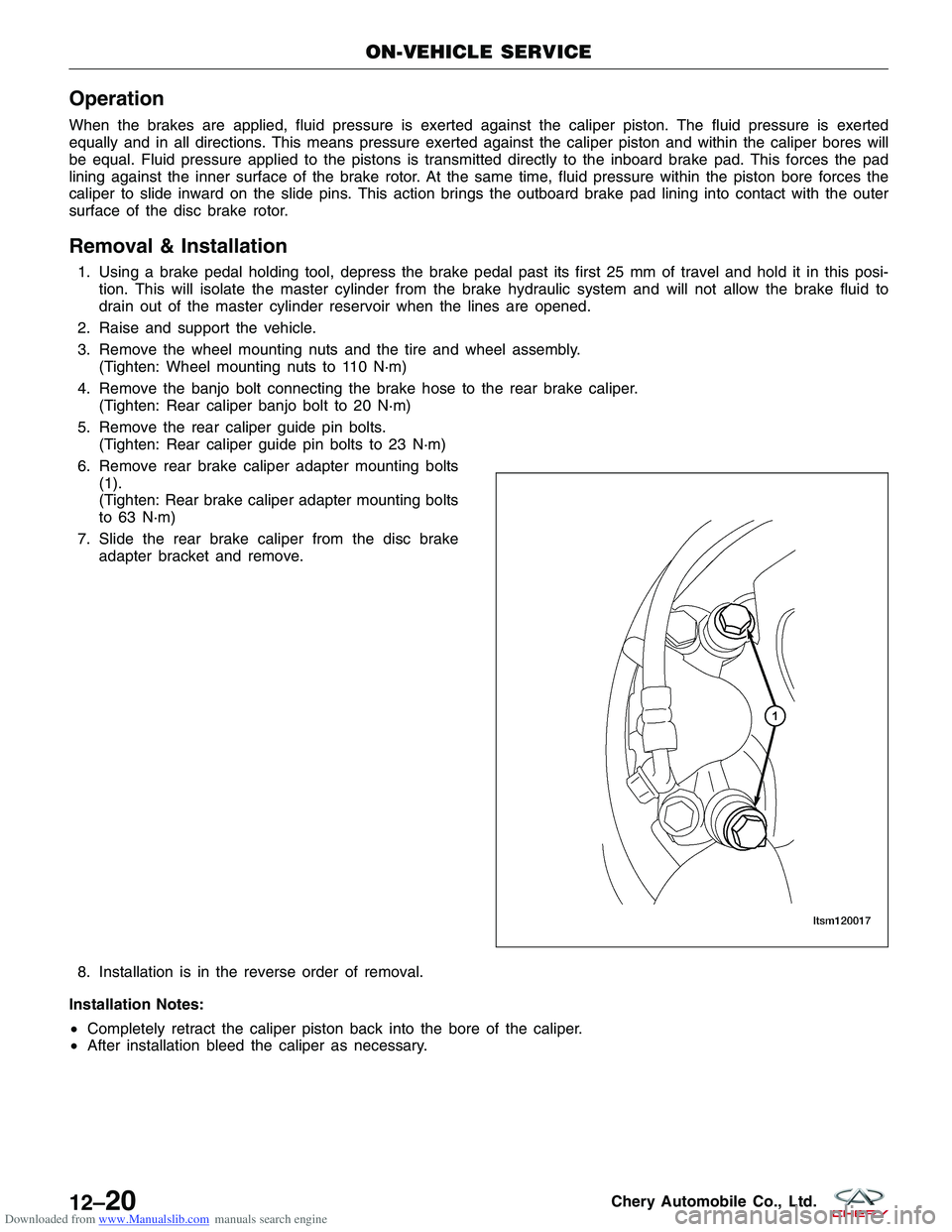
Downloaded from www.Manualslib.com manuals search engine Operation
When the brakes are applied, fluid pressure is exerted against the caliper piston. The fluid pressure is exerted
equally and in all directions. This means pressure exerted against the caliper piston and within the caliper bores will
be equal. Fluid pressure applied to the pistons is transmitted directly to the inboard brake pad. This forces the pad
lining against the inner surface of the brake rotor. At the same time, fluid pressure within the piston bore forces the
caliper to slide inward on the slide pins. This action brings the outboard brake pad lining into contact with the outer
surface of the disc brake rotor.
Removal & Installation
1. Using a brake pedal holding tool, depress the brake pedal past its first 25 mm of travel and hold it in this posi-tion. This will isolate the master cylinder from the brake hydraulic system and will not allow the brake fluid to
drain out of the master cylinder reservoir when the lines are opened.
2. Raise and support the vehicle.
3. Remove the wheel mounting nuts and the tire and wheel assembly. (Tighten: Wheel mounting nuts to 110 N·m)
4. Remove the banjo bolt connecting the brake hose to the rear brake caliper. (Tighten: Rear caliper banjo bolt to 20 N·m)
5. Remove the rear caliper guide pin bolts. (Tighten: Rear caliper guide pin bolts to 23 N·m)
6. Remove rear brake caliper adapter mounting bolts (1).
(Tighten: Rear brake caliper adapter mounting bolts
to 63 N·m)
7. Slide the rear brake caliper from the disc brake adapter bracket and remove.
8. Installation is in the reverse order of removal.
Installation Notes:
• Completely retract the caliper piston back into the bore of the caliper.
• After installation bleed the caliper as necessary.
ON-VEHICLE SERVICE
LTSM120017
12–20Chery Automobile Co., Ltd.
Page 1416 of 1903
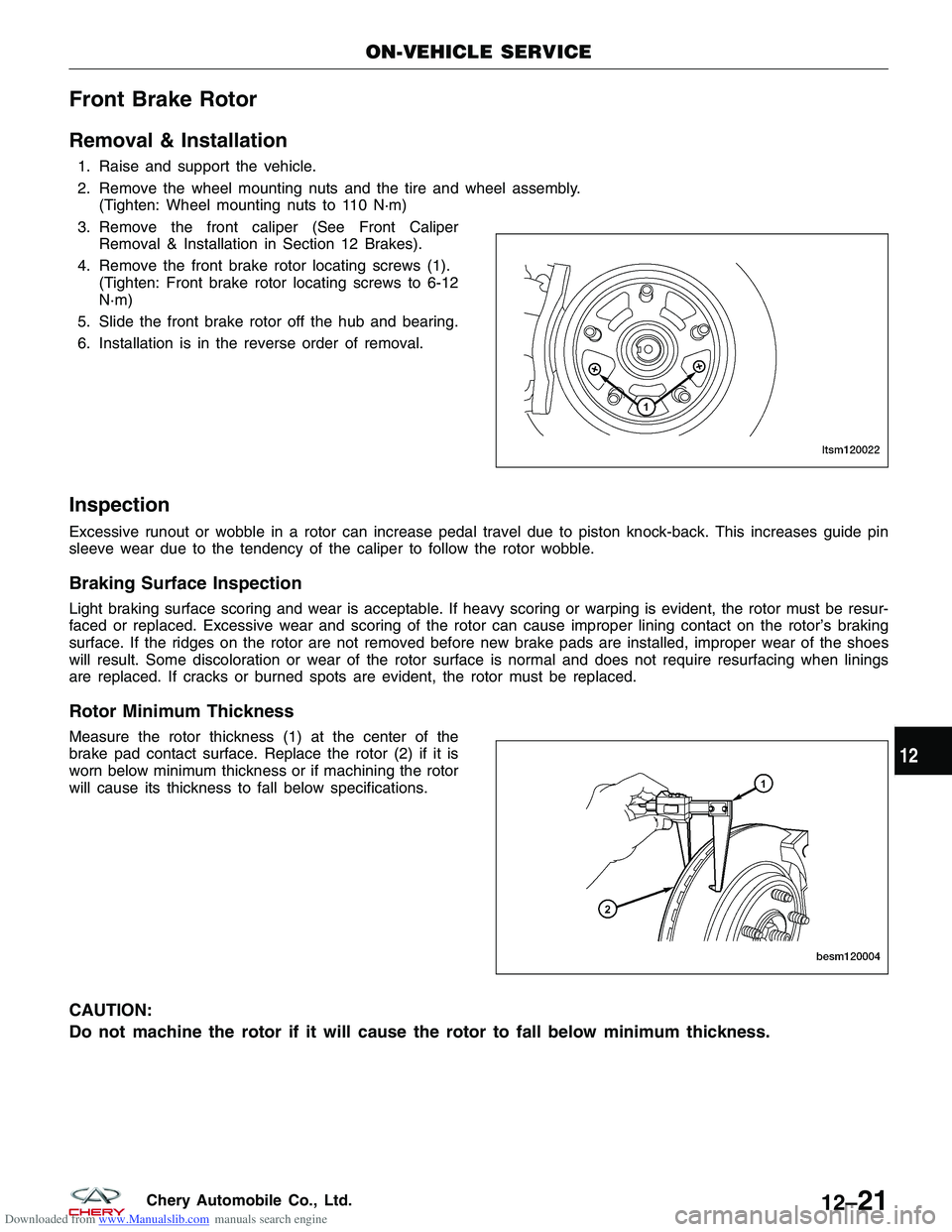
Downloaded from www.Manualslib.com manuals search engine Front Brake Rotor
Removal & Installation
1. Raise and support the vehicle.
2. Remove the wheel mounting nuts and the tire and wheel assembly.(Tighten: Wheel mounting nuts to 110 N·m)
3. Remove the front caliper (See Front Caliper Removal & Installation in Section 12 Brakes).
4. Remove the front brake rotor locating screws (1). (Tighten: Front brake rotor locating screws to 6-12
N·m)
5. Slide the front brake rotor off the hub and bearing.
6. Installation is in the reverse order of removal.
Inspection
Excessive runout or wobble in a rotor can increase pedal travel due to piston knock-back. This increases guide pin
sleeve wear due to the tendency of the caliper to follow the rotor wobble.
Braking Surface Inspection
Light braking surface scoring and wear is acceptable. If heavy scoring or warping is evident, the rotor must be resur-
faced or replaced. Excessive wear and scoring of the rotor can cause improper lining contact on the rotor’s braking
surface. If the ridges on the rotor are not removed before new brake pads are installed, improper wear of the shoes
will result. Some discoloration or wear of the rotor surface is normal and does not require resurfacing when linings
are replaced. If cracks or burned spots are evident, the rotor must be replaced.
Rotor Minimum Thickness
Measure the rotor thickness (1) at the center of the
brake pad contact surface. Replace the rotor (2) if it is
worn below minimum thickness or if machining the rotor
will cause its thickness to fall below specifications.
CAUTION:
Do not machine the rotor if it will cause the rotor to fall below minimum thickness.
ON-VEHICLE SERVICE
LTSM120022
BESM120004
12
12–21Chery Automobile Co., Ltd.